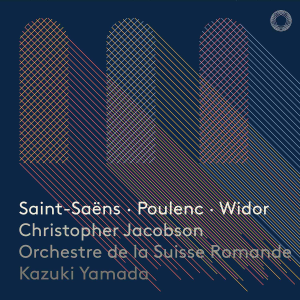
ESSENTIAL RECORDINGS

Camille Saint-Saëns: Symphony No. 3 in C Minor, Op. 78 ("Organ Symphony") Francis Poulenc: Concerto for Organ, Strings and Timpani in G Minor Charles-Marie Widor: Toccata from Symphony for Organ No. 5
In this day and age of instant gratification, and obsessive time-consuming devices and apps like smartphones and Facebook, if a composer approached a concert promoter with the idea for a new work written for a large orchestra including a grand piano, and a powerful pipe organ, this project would most likely never get off the printed page on the grounds that it would be too much of an undertaking and way too expensive to promote and produce. And yet in 1886, Camille Saint-Saëns (1835-1921) presented such an idea as a submission for a commission he had received from the London Philharmonic Society and it was an instant hit everywhere it was performed, and has become one of the most highly-regarded works for organ and orchestra as well as a respected symphony. Camille Saint-Saëns threw everything but the kitchen sink at it, but unlike the work by Poulenc, allows things to unfold in layers and unleashes all of the available forces in a sonic tidal wave during the gargantuan final movement. This highly expressive account by the Orchestre de la Suisse Romande under the direction of conductor Kazuki Yamada emphasizes the textural quality of the orchestral writing, and in doing so achieves a perfect one-to-one blend with the pipe organ during the beautiful Adagio movement. And as soon as organist Christopher Jacobson inveigle's every decibel of power from the Van den Heuvel Organ of Victoria Hall in Geneva at that crucial first chord of the final movement, then the gloves are off and a battle for supremacy ensues. Sure I've heard other recordings in which the organ was so loud that you would go around and check all your windows for cracks afterwards, but here it's the balance between the organ and the orchestral forces that strikes me as ideal. So much so that the very final, glorious chord generates a uniform and unwavering aural impact.
Just as impressive, but for different reasons, is the Concerto for Organ, Strings and Timpani in G Minor by Francis Poulenc (1899-1963). For one thing it's the pipe organ that opens the work with a loud and stern declamation. And throughout every movement the interplay between the strings and the organ is a wonderful thing to hear, as well as Poulenc's trademark style of blending sacred and profane elements and features together on the same page. Christopher Jacobson's perfectly judged stop registration within each movement always creates the ideal contrast between the pipes and strings, and again optimal balance of power is attained, in both soft and loud passages. The final two minutes of the work are Poulenc at his best, including the brief tip of the hat to Bach at the very end.
And if all this glorious music wasn't enough organist Christopher Jacobson tops it all off with a brilliant reading of one of the most famous organ pieces of all time. The Toccata from Charles-Marie Widor's Fifth Symphony for Organ. Jacobson's interpretation is slower than most I've heard, but after all, throughout most of the piece the right hand plays eight separate notes within each beat, so when played too fast everything becomes a blurry mess. His equanimous account well demonstrates the qualities of the instrument they have in Victoria Hall. Pentatone have once again produced a well engineered recording that despite all of these massive forces overwhelming the microphones, captures it all with plenty of headroom to spare.
Jean-Yves Duperron - June 2019